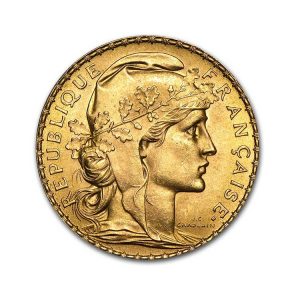Cette pièce 20Fr Napoléon en or est la version appelée “Génie”. Adaptation de l’immortel Génie de Duprey, ce type est caractéristique des débuts de la 3ème République.
Napoléon 20 Francs – Génie
CHF421.00
En stock
Vous souhaitez investir dans une pièce d’or Napoléon 20 Francs – Génie ?
Commandez donc en ligne ou auprès d’une de nos 25 agences d’achat et de vente d’or.
Gold Service vous garantit transparence et qualité pour l’ensemble de vos investissements dans les métaux précieux.
Napoléon 20 Francs – Génie
Le 20 Francs Génie est la pièce d’or la plus frappée après les Napoléon III et Marianne Coq.
Après la chute de l’empereur Napoléon III, la République eut besoin de nouvelles gravures. Il fut décidé de réutiliser l’emblématique dessin du Génie d’Augustin Dupré, déjà représenté sur les Écus dès 1792, sous la première République de France.
En rupture totale avec les Napoléon III, les 20 Francs Génie mettent en avant les valeurs de la IIIe République.
On retrouve l’inscription “LIBERTÉ EGALITÉ FRATERNITÉ” sur le revers, ainsi qu’une couronne de feuilles de chêne, la valeur faciale et la date de frappe.
A l’avers de la pièce, la gravure d’Augustin Dupré représente un ange appliqué à écrire sur une table de loi encore vierge. Sur l’ensemble des versions, on retrouve également les emblèmes français, un coq et le faisceau de licteur, surmonté d’une main de justice.
Caractéristiques :
- Produit : 20 Francs – Génie
- Origine : France
- Or fin : 5,81g
- Poids : 6,45g
- Titre : 900‰
- Diamètre : 21mm
- Frappe : A partir de 1871
Vous souhaitez avoir des informations supplémentaires sur nos pièces d’or disponibles ?
Contactez l’une de nos 25 agences d’achat d’or ou posez vos questions grâce à notre formulaire en ligne.
Pour aller plus loin
En numismatique, le napoléon est une pièce de monnaie d’or française de vingt francs, créée le 28 mars 1803 par le Premier Consul Napoléon Bonaparte. Elle a porté l’effigie de ce dernier mais aussi, au fil des régimes, celles de Louis XVIII, Charles X, Louis-Philippe, Napoléon III ou bien des symboles républicains. En 1815, au moment de la Restauration et du retour de la monarchie, l’usage veut que cette pièce retrouve son nom de « louis ». Il est vraisemblable que le nom de napoléon, et de son abréviation en « nap », soit devenu effectivement l’usage au cours du Second Empire français, durant l’expansion industrielle, commerciale et bancaire de la France.











J’ai commandé 2 Vrenelis de 10.- service top réactif, reçu en courrier signature, rapide, aimable et efficace.
Les lingots sont très bien, par contre le SAV est chaotique, indiquer livrable sous 2 – 3 jours, en stock et mettre près d’un mois à livrer et quand on réclame, on nous renvoie vers les directives, c’est juste scandaleux! Du coup, mes prochains achats ce feront chez vos concurrents
Très bon et agréable service client à Morges